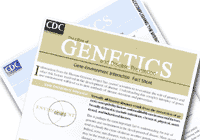
 The purpose of the Human Genome Epidemiology (HuGE) fact sheet is to provide a rapid public
health response to genetic discoveries. Fast facts from HuGENet™ will identify the gene, the variants, and associated diseases and will summarize what we know and what we don't know about the impact of the genetic discoveries on disease prevention and health promotion. The purpose of the Human Genome Epidemiology (HuGE) fact sheet is to provide a rapid public
health response to genetic discoveries. Fast facts from HuGENet™ will identify the gene, the variants, and associated diseases and will summarize what we know and what we don't know about the impact of the genetic discoveries on disease prevention and health promotion.
The audience is primarily public health professionals, program developers, policy makers, and legislators.
The language should be professional and yet simple enough to be understood by a reader who may not have a background in genetics. We will be providing a glossary. However, having to constantly refer to a glossary can be distracting to the reader. Be brief and simple to keep your reader's attention.
The template is self-explanatory but you should remember:
|
Items 1 and 2 should be accurate but only one sentence or two. |
|
Items 5, 6, and 7 will probably contain the most important information for the public health professional. This is our value added section where we make genetic discoveries relevant to the public health and preventive medicine. |
|
References and websites should be current and minimal. Remember, this is not a HuGE review. |
|
Please keep the information to one page; use the front and back. |
Timing is important. It is our intention to publish the fact sheet within one month of new genetic discoveries. HuGE fact sheets will be peer-reviewed for acceptance into HuGENet™. (Note: On occasion, the peer-review process may extend the timing of publications.)
Questions regarding editing, formatting, and publication should be emailed to HuGE@cdc.gov
Formatting, editing, layout, and clearance will be completed by the communications coordinator in the CDC's National Office of Public Health Genomics.
Be sure to include your name, telephone number, e-mail address, and the date of completion.
Mail the completed template to HuGE@cdc.gov
The National Office of Public Health Genomics thanks you for your participation in our HuGE fact sheet project.
Author(s) name
|
| E-mail: |
Telephone: |
| Date submitted: |
Revised: |
1. Title
Identify the title of the fact sheet, e.g., ApoE and Alzheimer's Disease.
2. Gene
Identify the gene being reviewed and provide a brief review of its chromosome location, the gene product, and its function, if known. (ONE SENTENCE)
3. Prevalence of Gene Variants
List known allelic variants and summarize current information on the prevalence of these variants in different populations and ethnic groups. Describe the populations from which these data are derived and evaluate the quality and representativeness of these data (in a FEW SENTENCES, please).
4. Disease Burden
Identify the disease(s) associated with this gene. Summarize the burden of disease in terms of relative risk, absolute risk, and attributable fraction in different populations. Comment on the quality and methodology of studies (briefly).
5. Interactions
Discuss whether the gene variants interact with any of the disease's known risk factors, including other genes and environmental factors. Summarize the magnitude of such interactions. Comment on the quality and methodology of studies (briefly).
6. Laboratory Tests
Summarize the sensitivity, specificity, and predictive values of biochemical and molecular tests available for this gene in different populations (briefly).
7. Population testing
Summarize current status of testing for this gene, including policy statements, recommendations, and legislation. Summarize data on the magnitude, determinants, and impact of testing on public health morbidity and mortality (briefly).
8. References
Include relevant Medline citations (3-5 please).
9. Internet sites
Include relevant links to various genetics databases, online resources, educational materials, policy statements, and support groups (limit to 3-4).
E-mail completed form to HuGE@cdc.gov. |


